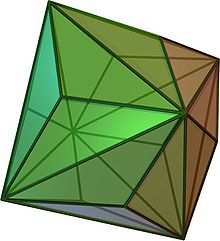3D view of a triakis octahedron (
animation )
The Triakis octahedron is a convex polyhedron , which is composed of 24 isosceles triangles and belongs to the Catalan solids . It is dual to the truncated hexahedron and has 14 corners and 36 edges.
Emergence If pyramids with the flank length are placed on the eight boundary surfaces of an octahedron (edge length ) , a triakis octahedron is created, provided the condition is met.
a
{\ displaystyle a}
b
{\ displaystyle b}
a
3
3
<
b
<
a
4th
6th
{\ displaystyle {\ tfrac {a} {3}} {\ sqrt {3}} <b <{\ tfrac {a} {4}} {\ sqrt {6}}}
For the previously mentioned minimum value of , the pyramids on top have the height 0, so that only the octahedron with the edge length remains.
b
{\ displaystyle b}
a
{\ displaystyle a}
The special triakis octahedron with equal face angles is created when is.
b
=
a
(
2
-
2
)
{\ displaystyle b = a \, (2 - {\ sqrt {2}})}
Takes the above maximum value, the triakis octahedron degenerates into a rhombic dodecahedron with the edge length .
b
{\ displaystyle b}
b
{\ displaystyle b}
If the maximum value is exceeded , the polyhedron is no longer convex and finally degenerates into a star tetrahedron .
b
{\ displaystyle b}
b
=
a
{\ displaystyle b = a}
Formulas
General
a
3
3
<
b
<
a
4th
6th
{\ displaystyle {\ tfrac {a} {3}} {\ sqrt {3}} <b <{\ tfrac {a} {4}} {\ sqrt {6}}}
Sizes of a triakis octahedron with edge lengths a , b
volume
V
=
a
2
3
(
a
2
+
2
3
b
2
-
a
2
)
{\ displaystyle V = {\ frac {a ^ {2}} {3}} \ left (a {\ sqrt {2}} + 2 {\ sqrt {3b ^ {2} -a ^ {2}}} \ right)}
Surface area
A.
O
=
6th
a
4th
b
2
-
a
2
{\ displaystyle A_ {O} = 6a {\ sqrt {4b ^ {2} -a ^ {2}}}}
Pyramid height
k
=
1
3
9
b
2
-
3
a
2
{\ displaystyle k = {\ frac {1} {3}} {\ sqrt {9b ^ {2} -3a ^ {2}}}}
Inc sphere radius
ρ
=
a
a
2
a
+
4th
b
{\ displaystyle \ rho \, = a \, {\ sqrt {\ frac {a} {2a + 4b}}}}
Dihedral angle a )
cos
α
1
=
12
b
2
-
5
a
2
-
8th
a
6th
b
2
-
2
a
2
9
(
4th
b
2
-
a
2
)
{\ displaystyle \ cos \, \ alpha _ {1} = {\ frac {12b ^ {2} -5a ^ {2} -8a {\ sqrt {6b ^ {2} -2a ^ {2}}}} { 9 (4b ^ {2} -a ^ {2})}}}
Dihedral angle b )
cos
α
2
=
2
b
2
-
a
2
4th
b
2
-
a
2
{\ displaystyle \ cos \, \ alpha _ {2} = {\ frac {2b ^ {2} -a ^ {2}} {4b ^ {2} -a ^ {2}}}}
Special
b
=
a
(
2
-
2
)
{\ displaystyle b = a \, (2 - {\ sqrt {2}})}
Sizes of a triakis octahedron with edge length a
volume
V
=
a
3
(
2
-
2
)
=
a
2
b
{\ displaystyle V = a ^ {3} (2 - {\ sqrt {2}}) = a ^ {2} b}
Surface area
A.
O
=
6th
a
2
23
-
16
2
{\ displaystyle A_ {O} = 6a ^ {2} {\ sqrt {23-16 {\ sqrt {2}}}}}
Inc sphere radius
ρ
=
a
5
+
2
2
34
{\ displaystyle \ rho = a {\ sqrt {\ frac {5 + 2 {\ sqrt {2}}} {34}}}}
Edge ball radius
r
=
a
2
{\ displaystyle r = {\ frac {a} {2}}}
Face angle
cos
α
=
-
1
17th
(
3
+
8th
2
)
{\ displaystyle \ cos \, \ alpha = - {\ frac {1} {17}} \, (3 + 8 {\ sqrt {2}})}
Web links
<img src="https://de.wikipedia.org//de.wikipedia.org/wiki/Special:CentralAutoLogin/start?type=1x1" alt="" title="" width="1" height="1" style="border: none; position: absolute;">
















